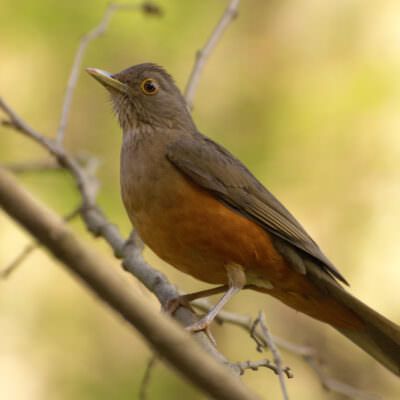Help Conserve Forests And Restore Balance To Our PlanetMake your gift go further (and greener) with a monthly pledge

Turdus rufiventrisLast updated on September 7, 2012
Rufous-bellied thrush, also called red-bellied thrush, is a member of the Turdidae family of birds, which is also home to well-known species like the nightingale, American robin, and bluebird. Due to its vivid orange-red belly and dark stripes running down its white throat, the rufous-bellied thrush is very easy to identify. Occasionally, a yellow ring around its eyes might be visible. With comparatively long, thin legs, thrushes hop along the ground as opposed to walking.
The southern and eastern regions of Brazil, Paraguay, Uruguay, and adjacent regions of Bolivia and Argentina are home to the rufous-bellied thrush. One of the most well-known thrushes in this area, it is frequently spotted in backyards, gardens, parks, and the edges of forests. When the weather in southern Brazil warms up again, the rufous-bellied thrush migrates north to the warmer tropical zone for the winter and then returns to the temperate zone. These birds are solitary or prefer to live in pairs. The female lays two to six pale-colored, speckled eggs in a cup-shaped nest she constructs out of grass, leaves, and moss. In the wild, these thrushes can live for 25 to 30 years.
Due to their primarily insectivorous diet, rufous-bellied thrushes consume a lot of insects and spiders. Additionally, they enjoy eating mature papayas, oranges, and coconuts from various palm tree species. They spit out the pits after about an hour, which aids in the spread of these plants.
Similar to numerous thrushes, this particular bird is frequently offered for sale as a cage bird in Brazil due to its captivating song. Deforestation-related habitat destruction is another constant threat to these birds’ survival. In October 2002, the rufous-bellied thrush was designated as Brazil’s national bird, potentially contributing to the species’ continued survival there.
BEHAVIOUR: The Rufous-bellied Thrush feeds mainly on invertebrates and fruits. Invertebrates include earthworms, woodlice, insects and spiders. Berries and other wild fruits from various plant species are considered fruits. This species has been observed to capture tiny fish and freshwater shrimp. It feeds and forages on the ground, sometimes along the exposed edges of lagoons and pools and frequently beneath the cover of vegetation.
HABITAT: The Rufous-bellied Thrush is found in lowland humid woodlands, as well as other wooded areas like plantations, groves, clearings, forest edges, and patches of brush and scrub. In Bolivia, the species can be seen from sea level to 2,600 meters. It can happen in urban parks, gardens, and the boundaries of farmed areas. However, in the drier parts of the range, it is frequently limited to places that are close to water.
REPRODUCTION: The breeding season varies slightly according to the range. The Rufous-bellied Thrush constructs a sizable cup-shaped nest in a tree near the trunk between one and three meters above the ground. The structure is made with roots and plant fibres. Dried grasses, twigs, and mud cover the interior cup. The cup is often rimmed with cow dung. Some nests are unique, with a cup of mostly green moss or hardened earth at different heights in bushes or trees.
VOICE: SOUNDS BY XENO-CANTO The Rufous-bellied Thrush gives melodic song, a fast, rich carolling, often in the early morning before dawn. This song is usually given from hidden perch. The song is typically slow, but during the breeding season, it becomes a loud melodious lilting series of varied phrases koro koro-cheeere cheeeerie-tooodle and a monotonous dialect song dewee-dewo dewee-dewo, fewri-tewri In non-breeding period, the song differs and becomes more resonant juh-joeit, drew-wip, drew-wip, drew-wip
The adult male’s head and face are slightly washed grey, with olive-brown upperparts. Wings and tail are browner. The throat and chin are white with faint brown streaks on the underparts. The breast is mostly buffish to pale buffish-brown. Rest of underparts are bright orange to orange-rufous. The bill is dark at the base and pale towards the top of the mandible. The eyes are dark brown, surrounded by narrow orange-yellow eyering. Legs and feet can range in color from light pink to purplish-horn.
FAQ
Which is the national animal of Brazil?
What is Brazil’s bird?
What is the largest bird in Brazil?
What is the national bird of New Brazil?